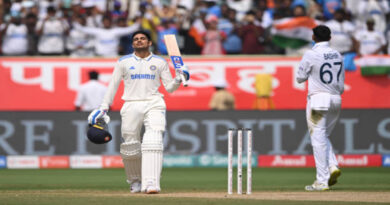Rohit Sharma’s bold new batting template has changed his ODI game – and India’s
No one grieves about the decrease in how much ODI cricket between the last World Cup and this one. You can’t fault them. In any case, it is a disgrace that because so minimal 50-over cricket is played, and, surprisingly, less by the best players, we could some of the time neglect to see groundbreaking bits of work. Rohit Sharma’s change since he turned into the full-time India ODI commander may very well be one of those.
In a World Cup, however, everybody takes note. After the duck in the first match in quite a while against Australia, Rohit has essentially finished two matches inside the first powerplay. He scored 76 off 43 in the initial ten overs against Afghanistan, and 45 off 30 against Pakistan. Similarly, as with all that he does, this was not arbitrary. Not an instance of having a decent outlook on it on the day and swinging for the slopes.
He has been batting with raised goals in ODIs for some time now. Starting from the beginning of 2022, which is the point at which he accepted the captaincy, 35 hitters have scored at least 300 runs inside the first powerplay in ODIs. Just two have gone faster than Rohit’s strike pace of 111. Neither of these two – Travis Head and Phil Salt – has scored almost however many runs as Rohit, nor is both of them in an influential position.
Upheavals in cricket are for the most part arranged by chiefs however established by youths. The skipper – normally a hitter – seldom takes on unsafe work. Throughout the entire existence of the game, just two commanders have gone magnificently crazy for an extensive timeframe: Brendon McCullum in 2015 and Chris Gayle in 2009.
McCullum scored at 163 in the initial ten overs through 2015, and Gayle at 117 in 2009. That, however, is their temperament. Rohit’s technique has been unique. The circle back in his profession fixated on his becoming fixated on not getting out in the initial 20 balls, and afterward, bit by bit advancing before detonating towards the end. He has changed the entire way of thinking about his batting. Not only has he transformed it, but all the more extraordinarily, he experienced disappointment when he began rolling out the improvement yet at the same time kept at it.
Everything started with T20Is, where India’s methodology with the bat was not exactly contemporary when he dominated. Potentially the new administration urged him the need to change. Perhaps he needed the change himself. Be that as it may, he needed to procure the option to have the option to advise others to put a lower cost on their wicket. He could never have done so without bringing down the cost of his wicket.
India didn’t win the 2022 T20 World Cup, however, Rohit kept at it in ODIs, which were becoming famous for the recipe of vigilant beginnings. What is challenging to sort out, however, is the reason the commander wanted to push the purpose so high so early. Troublesome because India watches their technique more savagely than potentially some other group on the planet.
However, it is an essential shift. India went from 4.44 an over in the batting powerplay in 2019 to 4.83 and 6.27 in 2022 and 2023. The years 2020 and 2021 had barely any ODI cricket in them. Before the 2019 World Cup, India went at better compared to five an over in only one year starting around 2012 – in 2013, which unexpectedly is when Rohit, Shikhar Dhawan, and Virat Kohli met up as their main three and ruled the run-scoring till the 2019 World Cup.
It has been an entertaining old year in ODI. In India recently, the new white ball was hooping around corners under the lights during the series against New Zealand and Sri Lanka. It guaranteed an entrancing World Cup, yet come the occasion, this parcel of balls is doing priceless little notwithstanding the odd exemption. The ball was seaming and swinging for eight overs in those days; presently it scarcely accomplishes for eight balls.
It is conceivable the absence of swing has encouraged Rohit further during this World Cup, yet his plan has been high even before this.

Considering how little India needs to part with, understanding their methodology here could require surmises, some more taught than others. It never damages to early crush the spirit of a pursuit. Rohit conceivably doesn’t believe average pursues should become precarious ones. The other conceivable explanation is that he needs to trust his center request more, and needs for them to not wind up as they did in the 2019 ODI World Cup semi-last. While you need to play however many balls as you can, you need to expand them. Assuming you in all actuality do get out doing that, your center request gets a chance to do likewise – rather than one fine day winding up battling a wide range of flames with no game time behind them.
It is more probable that Rohit showing others how it’s done to procure the option to request higher aim from others, yet in doing so he has looked exciting. Notwithstanding, you in all actuality do want to inquire as to why it took him, and India, so long.




Pingback: Shafique in quarantine as viral infection hits Pakistan camp - t20cricketzone
Pingback: ‘That’s a massive boost for us’ – Edwards pleased to get first big World Cup win out of the way - t20cricketzone
Pingback: India’s T20 World Cup Journey: Tough Questions and Options Ahead - t20cricketzone
Pingback: Rohit: ‘Moving On Wasn’t Easy’ – Reflecting on the World Cup Final Defeat - t20cricketzone
Pingback: Virat Kohli Withdraws from First Two England Tests for Personal Reasons - t20cricketzone
Pingback: IND vs ENG: Arrival of Spinner Shoaib Bashir in India Delayed Due to Visa Issues - t20cricketzone